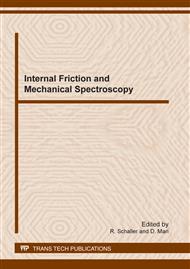p.233
p.239
p.245
p.251
p.257
p.265
p.271
p.277
p.283
Micro- and Macro-Plastic Properties of Be Polycrystals
Abstract:
The Young’s modulus and internal friction of Be polycrystals (grain sizes 6-60 μm) prepared with a powder metallurgy technique were studied acoustically in both amplitude independent and-dependent damping ranges. The measurements were made by composite oscillator at resonant frequencies of longitudinal vibrations of about 100 kHz in the temperature range of 100-873 K. The data were used to get information about micro-flow properties at vibration stresses of 0,2-30 MPa. It was found that the micro-flow diagrams became non-linear at amplitudes higher than 5 MPa. Mechanical properties (acoustic micro-flow stress σy, yield point σ0.2 and ultimate strength σВ) as functions of grain size have shown clearly a correlation in the framework of Hall and Petch law at room temperature but this similarity is not complete: stresses σ0.2 and σВ are one order of magnitude higher and change more steeply with grain size as compared to σy. The similarity is not observed for the temperature dependences. The values of σ0.2(Т) and σВ(T) decrease smoothly at higher temperatures but σу(Т) demonstrates an unusual minimum at ~400 K. The different behavior of the acoustic and mechanical stresses proves, evidently, that the ultrasonic energy losses and the flow stress level are due to the different nature of obstacles for the vibration (near equilibrium positions) and translation movement of dislocations in beryllium.
Info:
Periodical:
Pages:
257-262
Citation:
Online since:
January 2012
Authors:
Keywords:
Price:
Сopyright:
© 2012 Trans Tech Publications Ltd. All Rights Reserved
Share:
Citation:


